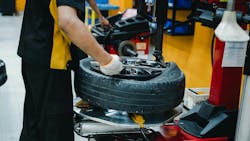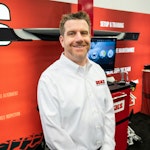Owner’s responsibility for safety
The responsibility for maintaining a safe work environment ultimately falls on the owner of the tire changer. By adhering to these guidelines, shop owners can ensure both machine and operator safety:
- Follow all installation instructions and ensure compliance with local, state, and federal codes.
- Conduct regular inspections to verify the correct functioning of the equipment.
- Train operators thoroughly on safe and proper tire changer usage.
- Use only authorized replacement parts for maintenance.
- Keep safety instructions and decals visible and accessible at all times.
Failing to uphold these responsibilities can compromise safety and increase the risk of accidents.
Protective equipment for operators
Personal protective equipment (PPE) is an essential line of defense against injuries during tire service activities. However, PPE is only effective when combined with safe operating practices. Operators should wear:
- Durable Clothing: Avoid loose-fitting garments to prevent entanglement in machinery.
- Leather Gloves: Protect hands from sharp edges and worn tires.
- Steel-Toed Shoes: Prevent injuries from heavy equipment or dropped tires.
- Eye Protection: Safety glasses or face shields protect against debris during tire servicing.
- Back Belts and Hearing Protection: Useful for lifting heavy tires and working in noisy environments.
By equipping operators with the right gear, shops can enhance safety and reduce the likelihood of workplace injuries.
The R.I.M. Safety Program
The R.I.M. program (Read, Inspect, Mount) offers a straightforward approach to tire servicing safety:
READ
Always verify the tire size and ensure it matches the rim. Mounting the wrong size tire can lead to catastrophic accidents, including tire explosions.
INSPECT
Examine both the tire and the rim for any damage. Look for rust, cracks, or tough spots that could prevent proper seating. Avoid using damaged tires or rims until they have been approved by a supervisor.
MOUNT
When mounting a tire, follow these safety tips:
- Never lean over the tire during inflation.
- Avoid inflating the tire beyond 40 psi if the bead does not seat properly.
- If the tire fails to seat, deflate it and inspect for issues before trying again.
Following the R.I.M. program ensures a systematic approach to tire servicing, minimizing the risks of accidents.
Common Tire Changer Safety Hazards
To operate a tire changer safely, it is essential to be aware of common hazards and how to address them:
- Damaged Beads: Stop and replace the tire if bead damage occurs during mounting.
- Rusty Wheels: Thoroughly inspect wheels for rust, especially in the bead seat area.
- Mismatched Tires and Wheels: Verify that tire and wheel diameters match exactly to prevent dangerous explosions.
- Improper Inflation: Always adhere to manufacturer-recommended inflation pressures.
- Standing Clear: Never position any part of your body over the tire changer during inflation.
By proactively addressing these hazards, operators can maintain a safer working environment.
Bead sealing, seating, and inflation
Bead sealing
Bead sealing captures air pressure between the tire and the rim. Initial bead sealing typically requires 1 to 2 psi.
Bead seating
Bead seating involves securing the tire on the rim. This process usually begins with the long tapered side of the wheel. If a tire requires more than 40 psi for bead seating, use a safety cage as an additional precaution.
Inflation
After bead seating, inflate the tire to the manufacturer’s recommended pressure. For most automobile tires, this range is between 24 and 45 psi. Overinflation can lead to severe risks, so never exceed the recommended limits.
Partnering with the Coats Company for safety
Final thoughts
Safety is a shared responsibility between shop owners, operators, and equipment manufacturers. By understanding hazard levels, using appropriate protective equipment, and adhering to safety programs like R.I.M., operators can mitigate risks associated with tire changers. Remember, a commitment to safety not only protects employees but also enhances productivity and trust in your automotive shop.



